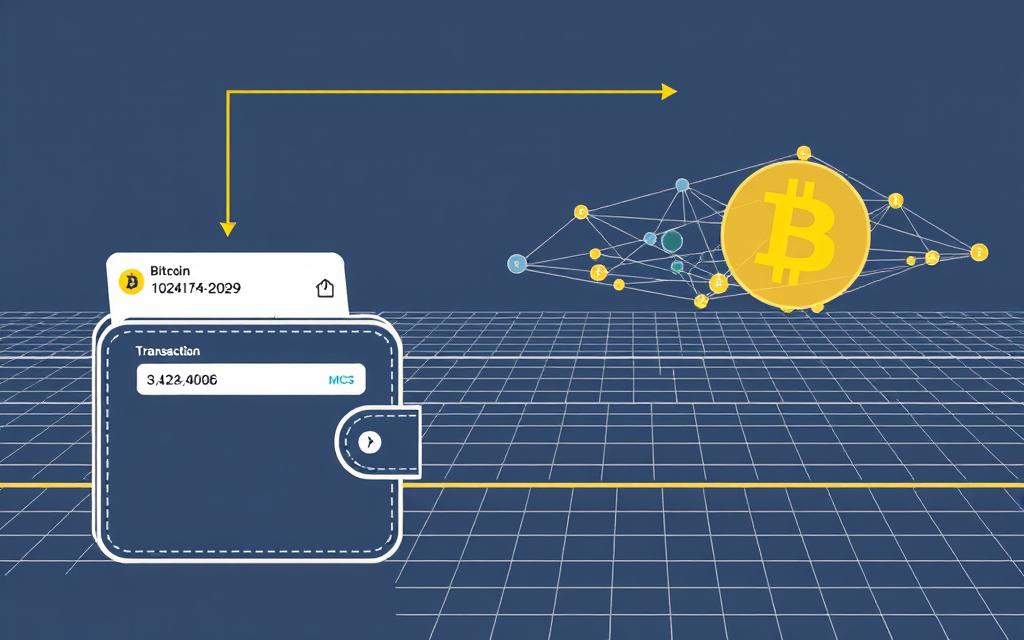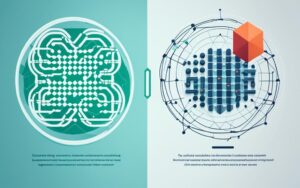Table of Contents
Many people confuse blockchain with cryptocurrency, but they serve different purposes. A decentralized digital ledger, blockchain securely records transactions across multiple computers. Digital currencies like Bitcoin rely on this technology but represent just one of its many applications.
Launched in 2009, Bitcoin introduced the first real-world use case for blockchain. However, this innovation extends far beyond financial transactions. Industries like healthcare, supply chain, and government now leverage its security and transparency.
This article clarifies the distinction between the two concepts. It also highlights how blockchain powers more than just digital money, offering solutions across various sectors.
Understanding Blockchain and Cryptocurrency
Digital innovation often blurs the line between blockchain technology and cryptocurrencies. While both rely on cryptography, their roles differ significantly. A decentralized ledger, for instance, ensures transparency without intermediaries.
What Is Blockchain Technology?
Imagine a digital ledger split into blocks, each linked via cryptographic hashes. This chain of records is distributed across a peer-to-peer network, making tampering nearly impossible. Unlike centralized databases, no single entity controls the data.
Key features include:
- Immutable records: Once added, blocks cannot be altered.
- Decentralization: Data is verified by multiple nodes.
- Trustless system: Participants rely on code, not third parties.
What Are Cryptocurrencies Like Bitcoin?
Bitcoin, the pioneer, uses a proof-of-work consensus to validate transactions. Its chain processes 4MB blocks every 10 minutes, secured by a 640 exahash/sec mining network. Wallets act as user-friendly interfaces to interact with this system.
Ethereum, by contrast, employs validators instead of miners. Over 33.8 million ETH are staked in its network, enabling applications like DeFi and NFTs. These cryptocurrencies like Bitcoin showcase just one use case for the underlying technology.
Key Differences Between Blockchain and Cryptocurrency
Think of blockchain networks as highways and cryptocurrencies as the vehicles driving on them. The first is the infrastructure; the second is just one way to use it. This distinction unlocks endless possibilities beyond digital money.
Blockchain as the Foundation
Like the internet powers email, decentralized ledgers enable cryptocurrency. Walmart slashed E. coli outbreaks by 90% using IBM’s Food Trust, a blockchain network tracking produce from farm to shelf. Other applications include:
- Smart contracts automating agreements without lawyers.
- Voting systems preventing tampering via immutable records.
Cryptocurrency as One Application
Bitcoin’s 20GB ledger (2014) shows how a bitcoin blockchain grows with use. Yet Ethereum’s Turing-complete design supports NFTs and DeFi—far beyond ETH tokens. Meanwhile, a 51% attack would require controlling most mining power, proving decentralized security.
Public chains (open to all) differ from private ones (e.g., corporate supply chains). Multiple digital assets can share a single ledger, just as apps share the internet.
How Does a Blockchain Work?
At its core, a decentralized ledger operates through interconnected blocks forming an unbreakable chain. Each block stores batches of transactions, timestamped and sealed using advanced cryptography. This design ensures data remains transparent and tamper-proof across the entire network.
The Role of Blocks and Chains
Every block contains three key elements: a header hash (unique fingerprint), a nonce (random number), and transaction data. Miners compete to solve complex puzzles by iterating the nonce until the hash matches the target. Bitcoin’s proof-of-work system, for example, adds a new block every 10 minutes.
Once validated, blocks link via SHA-256 hashing, creating an irreversible timeline. Ethereum’s proof-of-stake mechanism speeds this up to 15 seconds per block. Both methods rely on global nodes to sync and store identical copies of the ledger—now exceeding 200GB for Bitcoin.
Decentralization and Distributed Ledgers
A decentralized network eliminates single points of failure. Thousands of nodes cross-verify transactions, ensuring no single entity controls the data. If conflicting versions arise (a fork), the system adopts the longest valid chain as the truth.
This redundancy makes altering past entries nearly impossible. Each new block reinforces the ledger’s immutability, ideal for applications demanding audit trails—from supply chains to voting systems.
How Cryptocurrencies Use Blockchain
Digital assets rely on decentralized ledgers to function securely. The bitcoin blockchain set the standard, but many others now follow similar principles. This technology ensures every transaction remains transparent and tamper-proof.

Bitcoin and the First Blockchain
Launched in 2009, Bitcoin introduced a peer-to-peer electronic cash system. Its blockchain network processes payments without banks. Miners validate transactions by solving complex puzzles, earning 6.25 BTC per block as of 2024.
Key features of Bitcoin’s design:
- UTXO model: Tracks unspent outputs like digital cash.
- Transparent ledger: Anyone can audit the transaction history.
- Light nodes: Allow faster verification without storing the full chain.
Transaction Process on the Blockchain
When you send Bitcoin, the journey begins in your wallet. The request enters a mempool, waiting for miner confirmation. On average, six blocks must validate a transaction for full security.
| Step | Action | Time |
|---|---|---|
| 1 | Wallet initiates transfer | Instant |
| 2 | Mempool queues request | Minutes to hours |
| 3 | Miners include in block | ~10 minutes |
| 4 | Network confirms | 1 hour (6 blocks) |
Ethereum differs with account-based tracking and gas fees. Both systems prevent double-spending through decentralized consensus. For deeper insights, explore this guide on blockchain fundamentals.
Mining requires massive energy—Bitcoin uses 0.5% of global electricity. Yet, the security benefits justify the cost for many users. Privacy coins offer alternatives, but transparency remains Bitcoin’s hallmark.
Is Blockchain Only for Cryptocurrency?
From tracking lettuce to verifying diamonds, this technology reshapes multiple sectors. While digital currencies popularized decentralized ledgers, their applications span healthcare, logistics, and governance. Cities like Austin and Amman already leverage tamper-proof records for social good.
Beyond Cryptocurrencies: Diverse Applications
Walmart’s Food Trust traces 100% of leafy greens, slashing contamination risks. Similarly, De Beers uses a digital ledger to certify conflict-free diamonds. These supply chains showcase transparency at scale.
Key sectors adopting decentralized solutions:
- Healthcare: Hedera Hashgraph encrypts patient records, enabling secure sharing among providers.
- Government: Estonia’s X-Road system stores citizen data, reducing bureaucracy.
- Logistics: Maersk’s TradeLens cuts shipping delays by 40% via real-time tracking.
Examples of Non-Crypto Blockchain Uses
Austin issues homeless IDs on a decentralized network, restoring access to services. Jordan tracks Syrian refugees’ aid distribution, ensuring fairness. Microsoft’s Azure verifies certifications, while Everledger authenticates fine art.
“Blockchain isn’t just about money—it’s about trust. From farm to fork, or artist to auction, it creates accountability.”
| Industry | Use Case | Impact |
|---|---|---|
| Retail | Walmart’s produce tracking | 90% faster recalls |
| Humanitarian Aid | Refugee ID systems | Reduced fraud |
| Shipping | UPS route optimization | 15% fuel savings |
These innovations prove decentralized ledgers transcend financial transactions. They build resilient systems where transparency matters most.
Blockchain Security: How Safe Is It?
Security remains a top priority in decentralized systems, with advanced measures protecting sensitive data. While headlines often highlight hacks, the underlying technology offers robust defenses. Understanding these safeguards helps users navigate risks effectively.
Immutable Records and Tamper Resistance
Cryptographic hashing locks each block into the blockchain network. SHA-256 encryption, used by Bitcoin, makes altering records nearly impossible—odds are 1 in 2^128. Digital signatures further verify transaction authenticity.
Quantum computing poses future threats to current encryption. However, upgrades like quantum-resistant algorithms are already in development. Multi-signature wallets add corporate-grade protection, requiring multiple approvals for transfers.
Protection Against Fraud and Hacks
Exchange breaches ($1.9B lost in 2022) often target centralized storage, not the blockchain networks themselves. Hardware wallets like Ledger Nano isolate private keys offline, thwarting remote attacks.
- Zero-knowledge proofs: Used by Zcash to validate transactions without revealing data.
- Regulatory compliance: FINRA and SEC guidelines enforce custodial standards.
- Insurance products: Cover assets held by qualified custodians.
While no system is flawless, decentralized ledgers provide unmatched security for transparent and traceable operations.
Blockchain Transparency and Privacy
Public visibility of transactions raises both trust and privacy concerns. Decentralized ledgers expose data to all participants, yet demand robust safeguards for sensitive details. This tension shapes how blockchain networks serve enterprises and individuals alike.
Public vs. Private Ledgers
Bitcoin’s public ledger displays wallet balances openly, enabling audits but sacrificing anonymity. In contrast, Hyperledger Fabric restricts access to authorized entities—ideal for corporate data like medical records or trade secrets.
Key differences:
- Public chains: Dogecoin’s open ledger vs. Ripple’s permissioned system for banks.
- Private key management: Enterprises use hardware modules to secure access.
- GDPR clashes: Immutable records complicate EU “right to be forgotten” mandates.
Pseudonymity vs. True Anonymity
Bitcoin addresses mask identities but link transactions permanently. Monero’s ring signatures and Zcash’s ZK-SNARKs break these ties, ensuring financial privacy. Tools like Wasabi Wallet further obscure trails via CoinJoin mixing.
“CBDCs must walk a tightrope—preventing illicit activity while respecting user privacy.”
Dubai’s government services showcase hybrid models. Citizen IDs use permissioned chains, while public audits verify integrity. Such innovations prove transparency and privacy aren’t mutually exclusive.
Blockchain vs. Traditional Banking Systems
Financial systems worldwide face a critical evolution as decentralized networks challenge traditional banking models. While banks rely on intermediaries, decentralized ledgers enable peer-to-peer exchanges with unmatched speed and transparency.
Speed and Efficiency Comparisons
SWIFT transfers take 3–5 days to settle cross-border payments. Ripple’s network completes the same transaction in 4 seconds. Stablecoins like USDC mirror this efficiency, clearing in minutes versus ACH’s 1–3 business days.
JPMorgan’s Onyx processes $1B daily in interbank settlements, slashing delays. McKinsey estimates $1.7T in fee savings by 2030 as institutions adopt similar rails.
Eliminating Middlemen with Blockchain
Correspondent banking adds layers of fees—up to 6.9% for remittances. Decentralized alternatives cut costs to 1%, as seen with El Salvador’s Bitcoin adoption. Migrant workers now send money home without losing a week’s wages.
- Decentralized lending: Platforms like Aave automate loans without bank approvals.
- CBDC prototypes: China’s digital yuan and Nigeria’s eNaira test state-backed digital money.
“FedNow’s 24/7 payments are a step forward, but blockchain’s borderless design is the future.”
Real-World Applications of Blockchain Technology
Global industries now harness decentralized ledgers for transformative solutions. Beyond digital currencies, blockchain technology ensures transparency in supply chains and secures sensitive records. From food safety to medical data, these innovations redefine accountability.
Revolutionizing Supply Chain Management
IBM’s Food Trust slashes outbreak tracing from weeks to 2.2 seconds. Walmart uses it to track mango shipments, reducing recall times by 90%. Similar systems authenticate luxury goods and conflict-free diamonds:
- VeChain: Verifies Louis Vuitton bags via QR codes.
- De Beers’ Tracr: Certifies diamond origins, curbing fraud.
- USDA: Monitors food stamp distribution with tamper-proof logs.
“Blockchain turns traceability from a liability into a competitive edge.”
| Industry | Solution | Impact |
|---|---|---|
| Retail | Walmart’s produce tracking | 90% faster recalls |
| Luxury | VeChain authentication | 100% counterfeit prevention |
| Pharma | MediLedger serialization | $200B/yr fraud reduction |
Transforming Healthcare Record Keeping
BurstIQ encrypts patient records, enabling HIPAA-compliant sharing. The UAE’s cancer registry uses decentralized ledgers to streamline research. Key advancements include:
- ProCredits: Instantly verifies medical licenses.
- Chronicled: Tracks COVID vaccines in real-time.
- Red Cross: Secures refugee health data globally.
These cases prove blockchain technology transcends finance, building trust where it matters most.
Blockchain in Voting Systems
Election integrity gets a tech upgrade with decentralized solutions. Governments now pilot blockchain-backed systems to eliminate fraud and expand access. From military ballots to municipal elections, this software ensures every vote counts—literally.

Preventing Election Fraud
West Virginia tested mobile voting in 2018, securing ballots via a distributed network. Estonia’s i-Voting framework, operational since 2005, uses cryptographic signatures to authenticate voters. Key advantages include:
- End-to-end verifiable systems: Voters confirm their ballot’s inclusion without revealing choices.
- Immutable audit trails: Moscow’s 2020 election logged 700K+ votes on a public ledger.
- UN pilots monitor elections in emerging democracies, detecting anomalies in real-time.
Enhancing Voter Accessibility
Voatz’s platform enables overseas troops to vote via smartphones. South Korea’s digital IDs streamline registration, while audio ballots assist blind voters. Zero-knowledge proofs anonymize data, balancing privacy with transparency.
“Blockchain turns voting into a verifiable, yet private, civic act.”
| Initiative | Innovation |
|---|---|
| Voatz | Military mobile voting |
| South Korea | Blockchain voter IDs |
Smart Contracts: Automating Agreements
Self-executing digital contracts transform how businesses and individuals enforce deals. Built on decentralized software, these tools automatically trigger actions when preset conditions meet. Over $50 billion in assets now flow through such systems daily.
The Mechanics Behind Smart Contracts
Ethereum’s ERC-20 standard powers most tokenized agreements. Each contract contains immutable code that runs across a distributed network. Chainlink’s oracle feeds real-world data like weather or stock prices into these programs.
Key components include:
- Programmable logic: “If X happens, execute Y” rules written in Solidity
- Token standards: ERC-721 for NFTs, ERC-1155 for hybrid assets
- Decentralized governance: DAOs use token voting to amend terms
Advantages Over Paper-Based Systems
Traditional contracts require lawyers and courts for enforcement. AXA’s Fizzy platform automatically pays flight delay claims when airline data confirms disruptions. Shell uses similar software to manage energy trades.
| Feature | Smart Contracts | Traditional Contracts |
|---|---|---|
| Speed | Seconds to execute | Weeks for enforcement |
| Cost | $0.50 average gas fee | $15,000+ legal fees |
| Transparency | Public ledger records | Private documents |
“Our blockchain pilots process derivatives 90% faster than legacy systems.”
While jurisdictional recognition varies, 34 U.S. states now accept smart contracts as legally binding. Programmable escrows release funds only when both parties fulfill obligations, reducing disputes.
Blockchain for Digital Identity Verification
Over a billion individuals worldwide lack official identification documents. Decentralized systems now offer tamper-proof solutions, securing records while empowering marginalized people. From refugees to corporate users, this technology bridges gaps in trust and accessibility.

Securing Personal Data
The Sovrin Network enables self-sovereign identities, letting users control who accesses their data. Microsoft’s ION processes 10,000+ IDs per second on the Bitcoin network, ensuring scalability. Civic adds biometric checks, linking fingerprints to immutable records.
PayPal’s KYC software uses similar frameworks to streamline onboarding. Alibaba verifies academic diplomas, while India’s land registry prevents fraudulent claims. These systems eliminate middlemen, reducing identity theft risks by 90% in pilot programs.
Helping Refugees and the Homeless
UNHCR issues blockchain IDs to Rohingya refugees, restoring access to aid and healthcare. Illinois stores birth certificates on a distributed ledger, simplifying verification for homeless people. ShoCard’s airport integration speeds security checks without compromising privacy.
“A digital ID is more than convenience—it’s dignity. Blockchain gives displaced populations proof of existence.”
| Initiative | Impact |
|---|---|
| UNHCR IDs | 500K+ refugees served |
| Illinois Birth Certificates | 80% faster processing |
Environmental Impact of Blockchain
The rapid growth of decentralized systems has sparked intense debate about their ecological footprint. While these networks offer transformative benefits, their energy demands require careful consideration. This section examines both challenges and innovative solutions shaping a greener future.
Energy Consumption Concerns
Bitcoin’s proof-of-work mechanism currently consumes 0.5% of global electricity—more than Finland’s annual usage. Traditional mining operations rely heavily on fossil fuels, creating significant carbon emissions. However, newer approaches are changing this narrative.
Key comparisons between consensus mechanisms:
- Proof-of-Work (PoW): Bitcoin uses ~1,100 kWh per transaction
- Proof-of-Stake (PoS): Ethereum’s post-Merge system uses 0.03 kWh
- XRP Ledger: Processes transactions at 0.0079 kWh each
“The Merge reduced Ethereum’s energy consumption by 99.95% overnight—equivalent to Portugal going dark.”
Sustainable Blockchain Solutions
Innovators worldwide are pioneering eco-friendly alternatives. Gridless operates hydro-powered mining farms in Kenya, while Texas solar farms support Bitcoin operations during peak sunlight hours. These models demonstrate renewable energy’s potential.
| Initiative | Technology | Impact |
|---|---|---|
| Crypto Climate Accord | Net-zero roadmap | 250+ signatories |
| Toucan Protocol | Carbon credit tokenization | $20M+ offset |
| Green Bitcoin Mining | Renewable certification | 56% cleaner operations |
“Recycled heat from mining farms now warms Swedish greenhouses year-round. Tesla only accepts Bitcoin from verified renewable sources. These developments prove sustainability and decentralization can coexist.”
Future of Blockchain Technology
Decentralized systems continue evolving beyond their initial financial applications. Gartner predicts 30% of global enterprises will adopt this technology by 2026, while ISO 22739 standards ensure interoperability. These developments signal a shift toward mainstream integration across industries.

Emerging Trends Reshaping Digital Ecosystems
Web3 platforms merge with augmented reality, creating immersive commerce experiences. Decentraland’s virtual land parcels sold for $2.4 million, demonstrating metaverse economic potential. Key innovations include:
- Tokenized assets: Propy facilitates blockchain-based real estate deals in 45 countries
- Cross-chain bridges: Polkadot processes 1,000 transactions/second across parallel networks
- Quantum resistance: QRL’s lattice-based cryptography future-proofs sensitive data
Central banks pilot digital currencies, with 130 nations exploring CBDCs. The Lightning Network now handles 1M+ Bitcoin transactions daily at near-zero fees. These advancements address scalability while preserving decentralization principles.
Navigating the Road Ahead
EU’s MiCA regulations impose strict compliance for stablecoin issuers, potentially limiting innovation. Meanwhile, US executive orders push for responsible development frameworks. Technical hurdles remain:
- Quantum computing threats to current encryption standards
- Energy efficiency demands for IoT integration
- Data privacy conflicts with immutable ledgers
“The next five years will determine whether decentralized networks complement or replace legacy systems.”
As blockchain technology matures, its future lies in solving real-world problems—from supply chain transparency to digital identity management. The coming decade will test its ability to deliver on these promises at scale.
Pros and Cons of Blockchain
Evaluating decentralized systems requires balancing their revolutionary potential with practical limitations. While offering unprecedented transparency, these networks face technical and regulatory hurdles that affect adoption rates across industries.
Advantages of Decentralization
24/7 operational capability sets decentralized networks apart from traditional banking hours. R3 Corda’s enterprise solution processes 1 million transactions per second, dwarfing Bitcoin’s 7 tps capacity. This availability enables:
- Global financial access for unbanked populations
- Fraud reduction through immutable transaction records
- Automated compliance via smart contract triggers
Supply chain applications demonstrate these benefits. Walmart’s food tracking system reduced contamination investigations from weeks to seconds while cutting costs by 90%.
Limitations and Drawbacks
Scalability remains a critical challenge for public networks. Ethereum’s average $1.20 transaction fee (2024) still exceeds credit card processing costs for small payments. Key concerns include:
- Irreversible transactions creating recovery difficulties
- Enterprise education gaps slowing adoption
- Regulatory uncertainty across jurisdictions
| Factor | Traditional Systems | Decentralized Networks |
|---|---|---|
| Storage Costs | AWS S3: $0.023/GB | Ethereum: $15,000/GB* |
| Energy Efficiency | Visa: 0.002 kWh/tx | Bitcoin: 1,100 kWh/tx |
| Dispute Resolution | Court systems | Smart contract arbitration |
*Based on 2024 gas fees for 1GB data storage
“The technology’s immutability becomes a double-edged sword—perfect for audit trails, problematic for human errors.”
Legal systems are adapting slowly, with only 34 states recognizing smart contracts. However, pilot projects continue demonstrating the technology’s potential where transparency outweighs current limitations.
Conclusion
The digital revolution has clearly distinguished two transformative technologies. While cryptocurrency represents digital money, blockchain serves as its underlying architecture—and far beyond.
Industries from healthcare to logistics now leverage decentralized systems for transparency. Governments adopt them for secure voting, while artists use smart contracts for royalties. This versatility proves the technology’s value extends well beyond finance.
Ongoing innovation converges with AI and IoT, shaping Web3’s foundation. Balanced regulation will ensure stability without stifling progress. For deeper insights, explore this guide on blockchain fundamentals.
As adoption grows, education becomes crucial. Whether you’re a developer or entrepreneur, navigating cryptocurrency starts with understanding its building blocks. The future belongs to those who harness this potential responsibly.
FAQ
What is the difference between blockchain and cryptocurrencies?
Blockchain is the underlying technology that powers digital currencies like Bitcoin. While cryptocurrencies are a form of digital money, blockchain serves as a decentralized ledger for recording transactions securely.
Can blockchain be used for purposes other than cryptocurrencies?
Yes, blockchain has many applications beyond digital currencies. Industries like supply chain management, healthcare, and voting systems use it for secure record-keeping and transparency.
How does blockchain ensure security?
Blockchain uses cryptographic hashing and decentralization to make records tamper-proof. Each transaction is verified by multiple nodes, reducing fraud risks.
Are all blockchains public?
No, there are both public and private networks. Public ones like Bitcoin’s ledger are open, while private versions restrict access to authorized users.
Why is blockchain considered more efficient than traditional banking?
It eliminates intermediaries, speeding up transactions and lowering costs. Banks often take days to process transfers, whereas blockchain can do it in minutes.
What are smart contracts?
These are self-executing agreements written in code. They automate processes like payments when predefined conditions are met, reducing paperwork and delays.
Does blockchain have environmental concerns?
Some networks, like Bitcoin, consume significant energy due to mining. However, newer solutions like proof-of-stake reduce environmental impact.
How does blockchain improve supply chains?
It provides real-time tracking of goods, ensuring authenticity and reducing fraud. Companies like Walmart use it to trace food origins faster.
Can blockchain prevent election fraud?
Potentially, yes. It creates immutable voting records, making tampering nearly impossible while allowing secure remote participation.
What’s the future of this technology?
Experts predict wider adoption in finance, healthcare, and governance. Challenges like scalability and regulation must be addressed for mass use.









